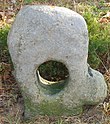Whistle wood
The Pfeifholz (also Pfeiffholz , whistle or woman Hainer whistle is called) a wooded area on the northern border of the Free State of Saxony for the state of Brandenburg in the district Meissen belonging municipality Röderaue . It is located between the locations of Frauenhain , Merzdorf and Wainsdorf .
history
The name of the whistle wood probably goes back to the name of a parcel. A reference to the whistling of the wind is also possible.
The forest area was first mentioned in a document in 1474 when the nickel of Pflugk was enfeoffed with the whistle wood and a two-speed water mill ("whistle mill") located here, which was operated by spring water. The size of the pipe was specified in 1588 by the land surveyor and cartographer Matthias Oeder from Saxony as 15 acres and 28 1 ⁄ 2 square rods. In that year the forest came into possession of the Saxon state. A short time later, in 1612, it was acquired by the Frauenhain estate.
In Pfeifholz there was also a first time in 1584 mentioned four was hooves comprehensive Vorwerk that the Thirty Years' War desolate fell. The Vorwerk, which was still unmanaged in 1682, received a post office with the Dresden - Berlin post line opened in 1712 . Among other things, the horses were changed at the so-called "Pfeifschenke". After the division of Saxony in 1815 as a result of the regulations of the Congress of Vienna , the Pfeifvorwerk became a border station and in 1818 a customs station was established here, which lost its importance in 1836 when the customs agreements between Saxony and Prussia were repealed . The Vorwerk later became a forester's house in which the Frauenhainer estate forester lived.
While the inn remained in operation until 1964, the mill, in which grain was ground into flour for the last time in 1955 and then only crushed, was shut down in 1960.
In 2010 a private herb garden with more than 150 different herbs can be found at Pfeifholz. In addition, some examples of the boundary stones made from Posta sandstone can be seen along the former Saxon-Prussian border line .
Say
Due to its remoteness, the whistle wood offered plenty of material for legends and stories. For example, shady figures are said to have overheard travelers in the inn and then robbed them in the dark forest. In the town of Elsterwerda, a few kilometers to the north, there is still an atonement cross , about which the legend reports that it was set up as atonement for the murder of a traveler in a pipe, in order to calm the haunted spirit of the victim buried here . In addition, there was said to have been a room in the pipe tavern behind the dining room with a blood stain that could not be removed.
Footnotes and individual references
- ^ A b Luise Grundmann, Dietrich Hanspach (author): Der Schraden. A regional study in the Elsterwerda, Lauchhammer, Hirschfeld and Ortrand area . Ed .: Institute for Regional Geography Leipzig and the Saxon Academy of Sciences in Leipzig. Böhlau Verlag, Cologne, Weimar, Vienna 2005, ISBN 3-412-10900-2 , pp. 182-184 .
- ↑ a b Martin Günther: The Gasthof zur Pfeife near Wainsdorf-Frauenhain. In: Home calendar for the Bad Liebenwerda district. Bad Liebenwerda 1965/66, pp. 158–161.
- ↑ The herb garden at the Frauenhainer Pfeife on www.city-map.de
- ↑ Wainsdorf: On a trial tour in the herb garden. In: Lausitzer Rundschau . August 12, 2008.
- ^ Museum of the Bad Liebenwerda District in conjunction with the German Cultural Association (publisher): Heimatjahrbuch 1969/70-Kreis Bad Liebenwerda-45 year of the former Heimatkalender. Bad Liebenwerda 1970, p. 94.
- ^ Georg A. Kuhlins: Stone cross legends from the district area. In: The Black Magpie. Our home in words and pictures. Bad Liebenwerda, 579 1980, pp. 1-3.
Web links
Coordinates: 51 ° 24 ′ 9.1 ″ N , 13 ° 30 ′ 14.4 ″ E



